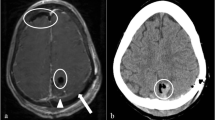Abstract
Introduction
Cerebrospinal fluid shunts are primarily used for the treatment of hydrocephalus. Shunt complications may necessitate multiple non-contrast head CT scans resulting in potentially high levels of radiation dose starting at an early age. A new head CT protocol using automatic exposure control and automated tube potential selection has been implemented at our institution to reduce radiation exposure. The purpose of this study was to evaluate the reduction in radiation dose achieved by this protocol compared with a protocol with fixed parameters.
Methods
A retrospective sample of 60 non-contrast head CT scans assessing for cerebrospinal fluid shunt malfunction was identified, 30 of which were performed with each protocol. The radiation doses of the two protocols were compared using the volume CT dose index and dose length product. The diagnostic acceptability and quality of each scan were evaluated by three independent readers.
Results
The new protocol lowered the average volume CT dose index from 15.2 to 9.2 mGy representing a 39 % reduction (P < 0.01; 95 % CI 35–44 %) and lowered the dose length product from 259.5 to 151.2 mGy/cm representing a 42 % reduction (P < 0.01; 95 % CI 34–50 %). The new protocol produced diagnostically acceptable scans with comparable image quality to the fixed parameter protocol.
Conclusion
A pediatric shunt non-contrast head CT protocol using automatic exposure control and automated tube potential selection reduced patient radiation dose compared with a fixed parameter protocol while producing diagnostic images of comparable quality.



Similar content being viewed by others
References
Bondurant CP, Jimenez DF (1995) Epidemiology of cerebrospinal fluid shunting. Pediatr Neurosurg 23(5):254–258, discussion 259
Stone JJ, Walker CT, Jacobson M, Phillips V, Silberstein HJ (2013) Revision rate of pediatric ventriculoperitoneal shunts after 15 years. J Neurosurg Pediatr 11(1):15–19. doi:10.3171/2012.9.PEDS1298
Pearce MS, Salotti JA, Little MP, McHugh K, Lee C, Kim KP, Howe NL, Ronckers CM, Rajaraman P, Sir Craft AW, Parker L, Berrington de Gonzalez A (2012) Radiation exposure from CT scans in childhood and subsequent risk of leukaemia and brain tumours: a retrospective cohort study. Lancet 380(9840):499–505. doi:10.1016/S0140-6736(12)60815-0
Sim J, Wright CC (2005) The kappa statistic in reliability studies: use, interpretation, and sample size requirements. Phys Ther 85(3):257–268
Brenner D, Elliston C, Hall E, Berdon W (2001) Estimated risks of radiation-induced fatal cancer from pediatric CT. AJR Am J Roentgenol 176(2):289–296. doi:10.2214/ajr.176.2.1760289
Frush DP, Donnelly LF, Rosen NS (2003) Computed tomography and radiation risks: what pediatric health care providers should know. Pediatrics 112(4):951–957
Shah DJ, Sachs RK, Wilson DJ (2012) Radiation-induced cancer: a modern view. Br J Radiol 85(1020):e1166–e1173. doi:10.1259/bjr/25026140
McCollough CH, Leng S, Yu L, Cody DD, Boone JM, McNitt-Gray MF (2011) CT dose index and patient dose: they are not the same thing. Radiology 259(2):311–316. doi:10.1148/radiol.11101800
Holmedal LJ, Friberg EG, Borretzen I, Olerud H, Laegreid L, Rosendahl K (2007) Radiation doses to children with shunt-treated hydrocephalus. Pediatr Radiol 37(12):1209–1215. doi:10.1007/s00247-007-0625-8
Udayasankar UK, Braithwaite K, Arvaniti M, Tudorascu D, Small WC, Little S, Palasis S (2008) Low-dose nonenhanced head CT protocol for follow-up evaluation of children with ventriculoperitoneal shunt: reduction of radiation and effect on image quality. AJNR Am J Neuroradiol 29(4):802–806. doi:10.3174/ajnr.A0923
Lee EJ, Lee SK, Agid R, Howard P, Bae JM, terBrugge K (2009) Comparison of image quality and radiation dose between fixed tube current and combined automatic tube current modulation in craniocervical CT angiography. AJNR Am J Neuroradiol 30(9):1754–1759. doi:10.3174/ajnr.A1675
Ozdoba C, Slotboom J, Schroth G, Ulzheimer S, Kottke R, Watzal H, Weisstanner C (2014) Dose reduction in standard head CT: first results from a new scanner using iterative reconstruction and a new detector type in comparison with two previous generations of multi-slice CT. Clin Neuroradiol 24(1):23–28. doi:10.1007/s00062-013-0263-5
May MS, Kramer MR, Eller A, Wuest W, Scharf M, Brand M, Saake M, Schmidt B, Uder M, Lell MM (2014) Automated tube voltage adaptation in head and neck computed tomography between 120 and 100 kV: effects on image quality and radiation dose. Neuroradiology 56(9):797–803. doi:10.1007/s00234-014-1393-4
Korn A, Bender B, Fenchel M, Spira D, Schabel C, Thomas C, Flohr T, Claussen CD, Bhadelia R, Ernemann U, Brodoefel H (2013) Sinogram affirmed iterative reconstruction in head CT: improvement of objective and subjective image quality with concomitant radiation dose reduction. Eur J Radiol 82(9):1431–1435. doi:10.1016/j.ejrad.2013.03.011
Strauss KJ (2014) Developing patient-specific dose protocols for a CT scanner and exam using diagnostic reference levels. Pediatr Radiol 44(Suppl 3):479–488. doi:10.1007/s00247-014-3088-8
Iskandar BJ, Sansone JM, Medow J, Rowley HA (2004) The use of quick-brain magnetic resonance imaging in the evaluation of shunt-treated hydrocephalus. J Neurosurg 101(2 Suppl):147–151. doi:10.3171/ped.2004.101.2.0147
Ethical standards and patient consent
We declare that all human and animal studies have been approved by the Washington University St. Louis Institutional Review Board and have therefore been performed in accordance with the ethical standards laid down in the 1964 Declaration of Helsinki and its later amendments. We declare that all patients gave informed consent prior to inclusion in this study.
Conflict of interest
JCR-G is an employee of Siemens, which manufactures the technology discussed in this manuscript. RM is being paid as an actor in a Siemens television advertisement featuring PET/MR. The CT scanners used by Mallinckrodt Institute of Radiology are manufactured by Siemens, exclusively.
Author information
Authors and Affiliations
Corresponding author
Rights and permissions
About this article
Cite this article
Wallace, A.N., Vyhmeister, R., Bagade, S. et al. Evaluation of the use of automatic exposure control and automatic tube potential selection in low-dose cerebrospinal fluid shunt head CT. Neuroradiology 57, 639–644 (2015). https://doi.org/10.1007/s00234-015-1508-6
Received:
Accepted:
Published:
Issue Date:
DOI: https://doi.org/10.1007/s00234-015-1508-6




